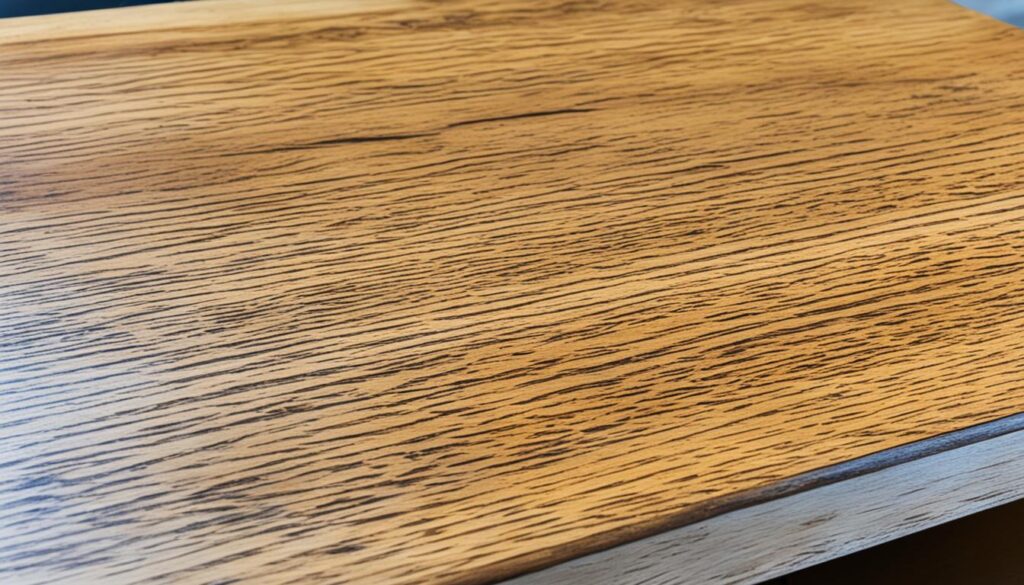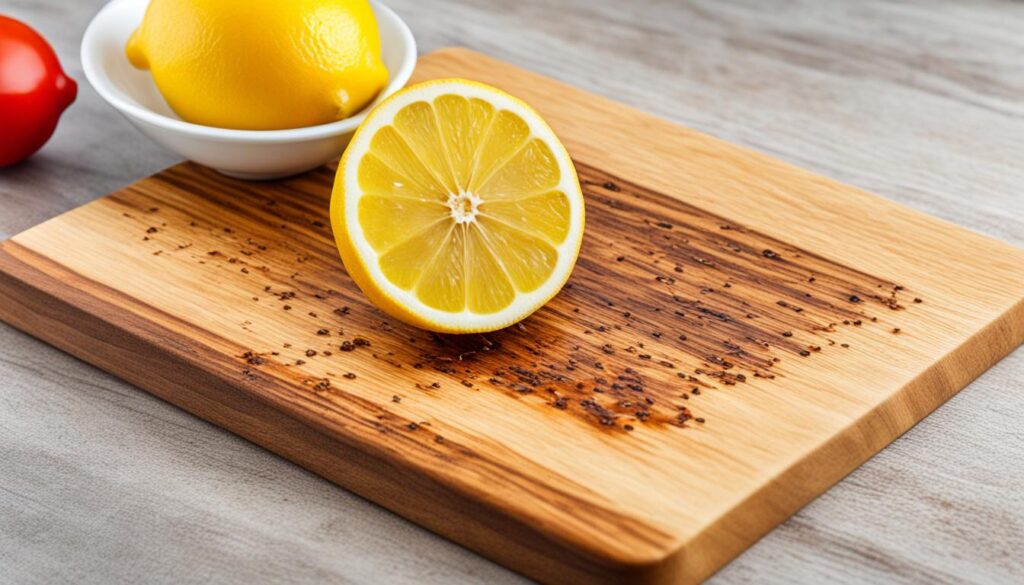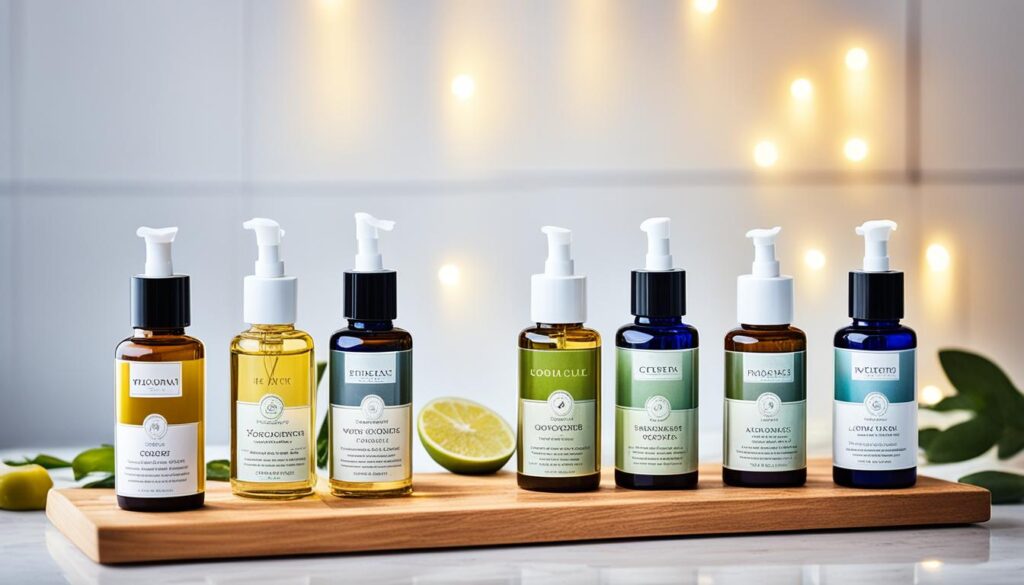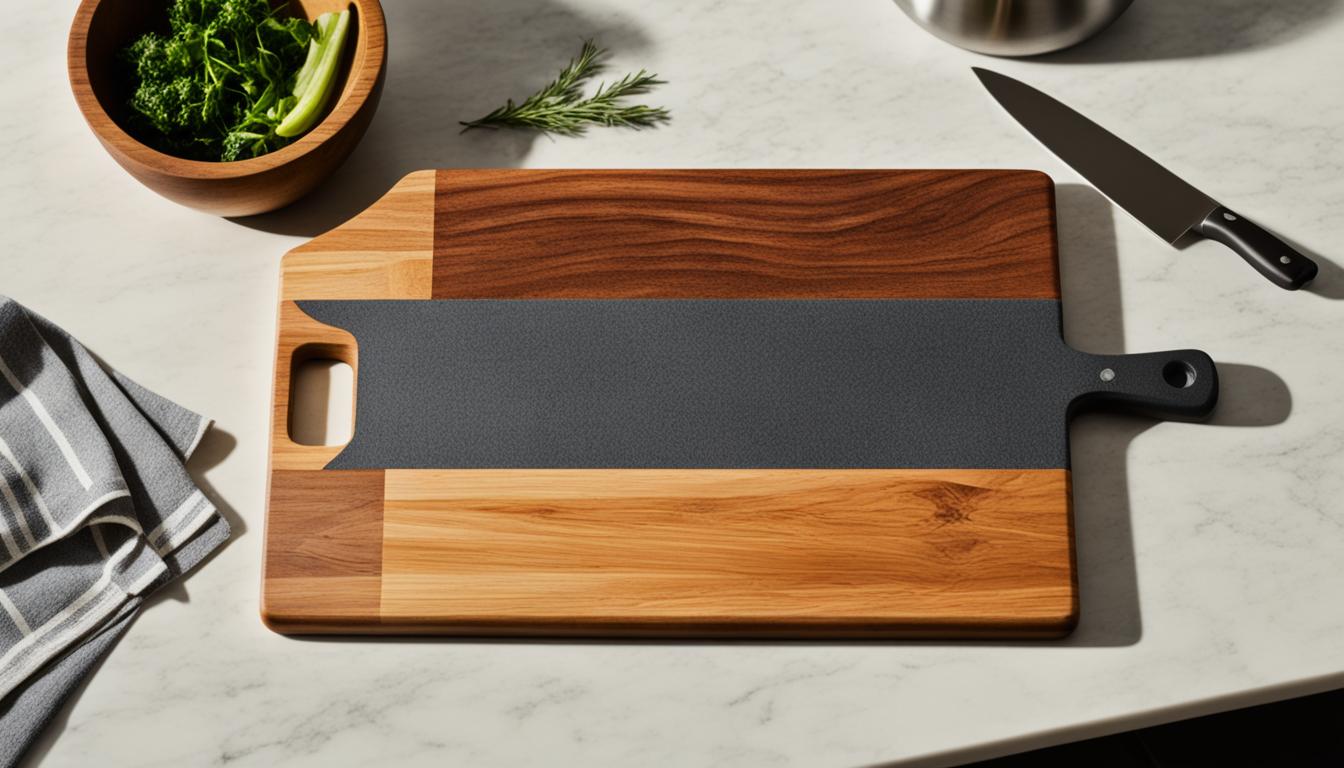Have you ever wondered how to properly season and maintain a wood cutting board? Are you tired of your cutting board warping, cracking, or absorbing juices? We have the answers you’ve been searching for! In this guide, we will share the best practices for wood cutting board maintenance, including tips on how to season the board, clean it effectively, and keep it in optimal cutting shape. Say goodbye to dull knives and hello to a beautifully preserved wood cutting board.
Key Takeaways:
- Seasoning a wood cutting board with food-safe mineral oil or board cream is crucial for preventing absorption and maintaining its shape.
- Choose wood as the ideal material for everyday use due to its knife-friendly nature and low bacteria survival rate.
- Proper cleaning and washing techniques, such as avoiding dishwashers and using soap and warm water, are essential for maintaining hygiene.
- Regularly apply cutting board oil or board cream to protect and preserve the wood, preventing it from drying out or developing cracks.
- Knowing when to oil the board is important to maintain its water-repellent qualities and prevent damage.
Selecting the Right Cutting Board Material
When it comes to selecting a cutting board, it’s important to choose the right material for your needs. While there are various options available, including glass, marble, plastic, and wood, each material has its pros and cons. In this section, we will compare the different materials and help you make an informed decision.
Glass and Marble Cutting Boards
Glass and marble cutting boards may look sleek and stylish, but they are not the best choice for everyday use. These materials are extremely hard and can quickly dull your knife blades, leading to inefficient cutting and a shorter lifespan for your knives.
Plastic Cutting Boards
Plastic cutting boards are a popular choice for their affordability and durability. They are especially suitable for heavy-duty tasks, such as cutting meat or pounding dough. However, plastic cutting boards can be difficult to clean thoroughly, as they may develop deep grooves that can harbor bacteria over time.
Wood Cutting Boards
Wood cutting boards are considered the best material for everyday use for several reasons. Firstly, wood is gentle on knife blades, helping to maintain their sharpness for longer. Secondly, wood has a natural ability to inhibit the survival of bacteria, making it a hygienic choice for food preparation. Lastly, wood cutting boards add a touch of warmth and elegance to any kitchen, enhancing its overall aesthetic appeal.
When choosing a wood cutting board, it’s crucial to opt for a high-quality board made from a hardwood, such as maple, walnut, or cherry. These woods are known for their durability and resistance to warping or cracking. A thick cutting board will also ensure stability and prevent any flexing or movement during use.
To summarize, when selecting a cutting board, wood is the ideal choice for everyday use. Its knife-friendly nature and low survival rate for bacteria make it a reliable and hygienic option. By investing in a high-quality wood cutting board, you’ll enjoy optimum performance, durability, and an aesthetically pleasing addition to your kitchen.
Cleaning and Washing a Wood Cutting Board
Proper cleaning and washing of a wood cutting board are essential for maintaining hygiene. When it comes to the care of your cutting board, follow these simple steps:
- Wash the cutting board with soap and warm water. Ensure that both sides of the board are thoroughly cleaned.
- Use mechanical scrubbing, such as a scrub brush or sponge, to remove bacteria and food particles from the surface of the board.
- Avoid using dishwashers to clean the board, as the high heat and water pressure can cause the wood to warp or splinter.
- Do not use bleach on your wood cutting board, as it can stain or excessively dry the wood, compromising its integrity.
- After washing the board, immediately dry it with a clean towel to prevent moisture from being absorbed into the wood.
- Allow the board to air dry in an upright position or on a raised rack with good air flow. This will help prevent the growth of bacteria and ensure proper drying.
By following these cleaning and washing practices, you can ensure that your wood cutting board remains clean, hygienic, and in optimal condition for all your culinary needs.
Remember, proper care for your cutting board involves not only cleaning but also regular oiling and maintenance. Learn more about applying cutting board oil and board cream in the next section.
Pros and Cons of Different Cleaning Methods
| Cleaning Method | Pros | Cons |
|---|---|---|
| Soap and Warm Water | – Effective at removing bacteria and food particles – Easy and affordable |
– Requires manual scrubbing – May take more time |
| Dishwasher | – Convenient and time-saving – Uses high heat for sanitation |
– Can cause warping or splintering of wood – Not suitable for all cutting boards |
| Bleach | – Powerful disinfectant – Kills bacteria effectively |
– Can stain or excessively dry the wood – Harsh chemicals may be harmful |
“Proper cleaning and washing are essential steps in maintaining the hygiene of your wood cutting board. By using soap and warm water, scrubbing away bacteria and food particles, and avoiding harsh cleaning methods, you can keep your cutting board in top condition for years to come.”
Applying Cutting Board Oil and Board Cream
Once the wood cutting board is thoroughly dry, it’s time to apply the necessary products to protect and maintain its quality. Applying cutting board oil and board cream regularly is essential for preserving the wood and prolonging its lifespan.
To begin, gather the following materials:
- Clean, dedicated towel or paintbrush
- Food-safe mineral oil
- Board cream
Follow these steps to properly apply cutting board oil:
- Generously apply the food-safe mineral oil to the board.
- Spread the oil evenly across the entire surface using the clean towel or paintbrush.
- Allow the oil to fully absorb into the wood.
- Leave the board to rest in an upright position, allowing the oil to penetrate and protect the entire board.
After the initial seasoning, it’s important to regularly maintain the board by reapplying a thin layer of oil whenever it starts to wear thin. This ensures that the board remains hydrated and protected.
In addition to cutting board oil, you can also use board cream to provide an additional protective barrier and help seal knife scars and cracks. Follow the instructions on the board cream packaging for the best application method.
Why choose food-safe products for cutting board maintenance?
Using food-safe cutting board oil and board cream is crucial to ensure the safety and hygiene of your food preparation surface. These products are specifically designed to be non-toxic and safe for contact with food. Regularly applying these products to your wood cutting board helps prevent the growth of bacteria and extends its lifespan.
Remember, always read the labels and choose trusted brands and products for cutting board maintenance. This will ensure that your wood cutting board remains in excellent condition and is safe to use for all your culinary endeavors.
| Product | Description | Price |
|---|---|---|
| Howard BBB012 Cutting Board Oil | Absorbs into the wood to prevent drying and cracking | $11.99 |
| John Taylor Butcher Block Conditioner | Contains natural waxes to seal and protect the wood | $15.95 |
| Catskill Craftsmen Board Cream | Rich formula that rejuvenates and protects the wood | $9.50 |
Knowing When to Oil the Cutting Board
To maintain the water-repellent qualities of your wood cutting board, it is essential to oil it regularly. By doing so, you will ensure its longevity and prevent any damage that may compromise its performance in the kitchen. But how do you know when it’s time to oil your cutting board? Look out for these signs of an oil-thirsty board:
- Water spreading instead of beading: Sprinkle some water on the board’s surface and observe. If the water droplets start to spread and penetrate the wood instead of forming small beads, it means the board needs oiling.
- Dry-looking patches: Dry areas or patches on the cutting board indicate that the wood is dried out and in need of nourishment.
- Fast absorption of water: If your board quickly absorbs water, it suggests that the wood is thirsty and requires oiling to replenish its moisture barrier.
- Dark stains: Dark stains on the surface of the cutting board can indicate that the wood is drying out and needs oil to restore its color and vitality.
- Funky smell: A musty or unpleasant odor emanating from your cutting board can be a sign of moisture absorption. Oiling the board can help eliminate the smell and restore its freshness.
By paying attention to these signs, you can ensure that your wood cutting board receives the care and maintenance it deserves. Regular oiling will not only keep it looking beautiful but also protect its integrity during use.

Sanding a Wood Cutting Board
If you notice scratches on your wood cutting board from heavy knife work, don’t worry! Sanding can help restore its surface and maintain its pristine condition. By following these simple steps, you can remove scratches and bring back the smoothness to your cutting board.
- Gather the necessary materials:
| Sanding Materials |
|---|
| Fine sandpaper (220 or 400 grit) |
| Damp sponge |
| Clean cloth for oiling |
Now that you have all the materials, let’s get started with the process of sanding your wood cutting board:
- Sanding the board:
Take the fine sandpaper (220 or 400 grit) and gently sand the surface of the cutting board. Use light, even pressure, and sand in the direction of the grain. This will help to remove the scratches and refine the surface. Be careful not to oversand or create uneven spots on the board.
Tip: If the scratches are deep or extensive, start with a coarser sandpaper (such as 120 or 180 grit) and gradually work your way up to the finer grit for a smoother finish.
- Cleaning the board:
After sanding, wipe off the dust and residue from the board using a damp sponge. This will help remove any remaining particles and ensure a clean surface for the next step.
- Drying and oiling the board:
Allow the cutting board to air dry completely. Once dry, apply a food-safe oil to nourish and protect the wood. Rub the oil onto the board using a clean cloth, ensuring even coverage. Let the oil penetrate the wood for a few hours or overnight.
Note: It’s crucial to use a food-safe oil such as mineral oil or a cutting board oil that is specifically designed for this purpose. Avoid using vegetable or cooking oils as they can spoil and leave an unpleasant odor on the board.
Your wood cutting board is now ready for use again! Sanding can help remove scratches and restore the surface, ensuring a smooth and safe cutting experience. Remember to regularly oil your cutting board to maintain its condition and protect it from moisture.
Using Lemon Juice or White Vinegar for Stains and Smells
Lemon juice or white vinegar can be incredibly effective in removing stains and eliminating unpleasant smells from your wood cutting board. These natural ingredients possess acidic properties that work to neutralize organic materials and fats that are causing the problem.
To use lemon juice or white vinegar, simply follow these easy steps:
- Identify the Stained or Smelly Areas: Begin by identifying the specific areas on your cutting board that are stained or emitting odors.
- Apply the Lemon Juice or White Vinegar: Squeeze fresh lemon juice directly onto the affected areas or pour a small amount of white vinegar onto a clean cloth or sponge.
- Gently Scrub the Board: Using the lemon juice or vinegar, gently scrub the stained or smelly areas of the cutting board. You can use a clean cloth, sponge, or a soft-bristled brush for this step.
- Rinse and Dry: Once you have thoroughly scrubbed the board, rinse it with clean water to remove any residue. Be sure to dry the cutting board completely with a clean towel.
This method is particularly useful for cutting boards that have been used with strong-smelling ingredients or heavily pigmented foods. The acidic properties of lemon juice and white vinegar help to break down and eliminate stubborn stains and odors, leaving your cutting board fresh and clean.
| Pros | Cons |
|---|---|
| Effectively removes stains and smells | May leave a mild scent of lemon or vinegar initially |
| Simple and cost-effective solution | Requires effort to scrub and rinse the cutting board |
| Gentle on the wood surface | Not suitable for cutting boards with delicate finishes or coatings |

Waxing the Cutting Board for Extra Protection
After properly oiling your wood cutting board, you can further enhance its durability and add an extra layer of protection by waxing it. Waxing creates a smoother surface that repels water, preventing moisture from seeping into the wood and causing damage. Additionally, it aids in sanitation by sealing any cracks or crevices where bacteria could accumulate.
To wax your cutting board, you will need a food-grade wax such as beeswax or a natural saturated oil. Here’s a step-by-step guide to waxing your cutting board:
- Ensure that your cutting board is clean, dry, and properly seasoned with oil.
- Take a small amount of wax and rub it onto the surface of the board in a circular motion, applying even pressure.
- Continue rubbing the wax until it melts and spreads evenly across the entire surface of the board.
- Once the wax has been evenly distributed, take a paper towel or a dry cloth and buff the surface of the board. This will help remove any excess wax and create a smooth finish.
Waxing your cutting board not only adds an extra layer of protection but also enhances its visual appeal. The wax creates a beautiful sheen on the surface, giving your cutting board a polished and professional look.
Remember to reapply wax periodically, especially if you notice the water no longer beads up on the surface or if the board starts to look dry. Regular maintenance will ensure that your cutting board remains in optimal condition and lasts for years to come.
Pro Tip: When applying wax to your cutting board, make sure to use only food-grade wax. This will ensure that no harmful substances are transferred to your food during the cutting process.
Comparing Waxing and Other Maintenance Methods
| Benefits | Drawbacks | |
|---|---|---|
| Waxing |
|
|
| Oil Application |
|
|
| No Maintenance |
|
|
By comparing the benefits and drawbacks of different maintenance methods, you can make an informed decision about how to best protect and care for your wood cutting board. While oil application provides some level of protection, waxing offers greater water resistance and sanitation benefits.
Recommended Products for Cutting Board Maintenance
When it comes to maintaining your wood cutting board, using the right products is essential. We recommend high-quality cutting board oils and creams that are specifically designed for food contact. These products ensure that your cutting board stays in optimal condition for years to come. However, it’s important to avoid natural oils like vegetable, corn, olive, peanut, and walnut oil, as they can go rancid and create unpleasant odors.
Instead, opt for trusted brands and products that are dedicated to cutting board care, such as those available on CuttingBoard.com. These products are specially formulated to nourish and protect the wood, keeping it looking beautiful and extending its lifespan. By using recommended cutting board oils and creams, you can enjoy the benefits of a well-maintained cutting board while also ensuring food safety.
Recommended Cutting Board Oils and Creams
| Brand | Product | Description |
|---|---|---|
| CuttingBoardStore | Cutting Board Oil | This food-grade oil is made from pure USP mineral oil and is perfect for seasoning and rejuvenating your cutting board. It is odorless, tasteless, and safe for food contact. |
| Chef’s Choice | Cutting Board Cream | This cream is a blend of natural beeswax and mineral oil, providing a protective barrier and enhancing the beauty of your cutting board. It is easy to apply and leaves a smooth, satin finish. |
| Howard Products | Butcher Block Conditioner | This conditioner is made from a combination of food-grade mineral oil, beeswax, and carnauba wax. It helps restore and maintain the natural beauty of your cutting board while protecting it from drying, cracking, and warping. |
| Bio Shield | Wood Counter and Cutting Board Oil | This oil is made from all-natural, plant-based ingredients and is suitable for both cutting boards and wooden countertops. It penetrates deep into the wood, providing long-lasting protection and a natural sheen. |
These are just a few examples of the recommended products available for cutting board maintenance. Remember to always follow the instructions provided by the manufacturer for best results. By using high-quality oils and creams, you can ensure that your wood cutting board remains in excellent condition, prolonging its lifespan and enhancing your culinary experience.

Benefits of Using a Wood Cutting Board
When it comes to selecting a cutting board, wood offers a multitude of advantages over other materials. Let’s explore why choosing a wood cutting board is a smart and practical decision.
Strength and Durability
Wood cutting boards are known for their strength and resistance to chipping or cracking. They can withstand heavy cutting and provide stability during use, ensuring a reliable surface for all your culinary endeavors.
Gentle on Knife Blades
Unlike other materials, wood cutting boards are gentle on knife blades. The natural properties of wood prevent excessive dulling, preserving the sharpness and longevity of your knives.
Enhanced Food Safety
Studies have shown that wood cutting boards have lower bacteria survival rates compared to other materials. Wood’s natural antimicrobial properties inhibit the growth and spread of harmful bacteria, making wood cutting boards safer and more hygienic for food preparation.
Aesthetic Appeal
Wood cutting boards not only excel in functionality but also contribute to the visual appeal of your kitchen. The natural warmth and beauty of wood add a touch of elegance to your culinary space, making it a pleasure to work in.
Multipurpose Usage
Wood cutting boards can serve multiple purposes beyond just chopping ingredients. They can double as stylish charcuterie boards, providing an impressive presentation for cheese platters, fruit displays, and other appetizers.
As you can see, there are numerous advantages to using a wood cutting board. Its durability, knife-friendly nature, heightened food safety, aesthetic appeal, and versatility make it the ideal choice for home cooks and professional chefs alike.
Conclusion
Properly season and maintain your wood cutting board to ensure its longevity and hygiene in the kitchen. By selecting the right cutting board material and following a regular cleaning routine, you can keep your board in optimal condition. Remember to apply food-safe oil or cream regularly to protect and nourish the wood.
Keep an eye out for telltale signs that your board needs attention, such as dry patches, fast water absorption, dark stains, or unpleasant odors. Address these issues promptly by sanding the board or using natural remedies like lemon juice or white vinegar.
For extra protection, consider waxing your cutting board to create a water-repellent surface and seal any cracks or crevices. Be sure to use recommended products that are specifically designed for cutting board maintenance and food contact.
Enjoy the many benefits of using a wood cutting board in your culinary endeavors, from its knife-friendly nature and lower bacteria survival rates to its durability and aesthetic appeal. With proper care, your wood cutting board will continue to serve as a reliable and stylish companion in the kitchen for years to come.
